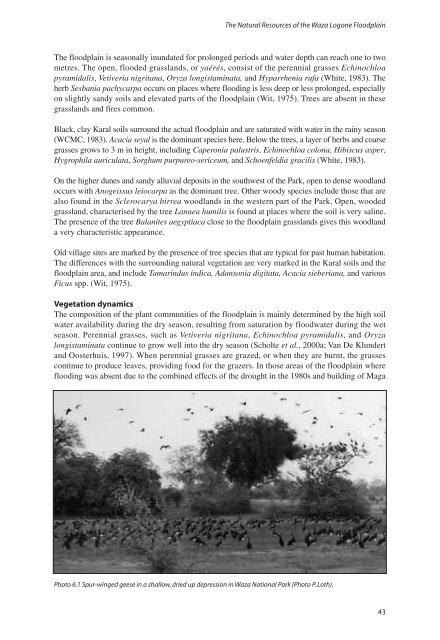The return of the water - IUCN
The return of the water - IUCN
The return of the water - IUCN
Create successful ePaper yourself
Turn your PDF publications into a flip-book with our unique Google optimized e-Paper software.
<strong>The</strong> Natural Resources <strong>of</strong> <strong>the</strong> Waza Logone Floodplain<br />
<strong>The</strong> floodplain is seasonally inundated for prolonged periods and <strong>water</strong> depth can reach one to two<br />
metres. <strong>The</strong> open, flooded grasslands, or yaérés, consist <strong>of</strong> <strong>the</strong> perennial grasses Echinochloa<br />
pyramidalis, Vetiveria nigritana, Oryza longistaminata, and Hyparrhenia rufa (White, 1983). <strong>The</strong><br />
herb Sesbania pachycarpa occurs on places where flooding is less deep or less prolonged, especially<br />
on slightly sandy soils and elevated parts <strong>of</strong> <strong>the</strong> floodplain (Wit, 1975). Trees are absent in <strong>the</strong>se<br />
grasslands and fires common.<br />
Black, clay Karal soils surround <strong>the</strong> actual floodplain and are saturated with <strong>water</strong> in <strong>the</strong> rainy season<br />
(WCMC, 1983). Acacia seyal is <strong>the</strong> dominant species here. Below <strong>the</strong> trees, a layer <strong>of</strong> herbs and coarse<br />
grasses grows to 3 m in height, including Caperonia palustris, Echinochloa colona, Hibiscus asper,<br />
Hygrophila auriculata, Sorghum purpureo-sericeum, and Schoenfeldia gracilis (White, 1983).<br />
On <strong>the</strong> higher dunes and sandy alluvial deposits in <strong>the</strong> southwest <strong>of</strong> <strong>the</strong> Park, open to dense woodland<br />
occurs with Anogeissus leiocarpa as <strong>the</strong> dominant tree. O<strong>the</strong>r woody species include those that are<br />
also found in <strong>the</strong> Sclerocarya birrea woodlands in <strong>the</strong> western part <strong>of</strong> <strong>the</strong> Park. Open, wooded<br />
grassland, characterised by <strong>the</strong> tree Lannea humilis is found at places where <strong>the</strong> soil is very saline.<br />
<strong>The</strong> presence <strong>of</strong> <strong>the</strong> tree Balanites aegyptiaca close to <strong>the</strong> floodplain grasslands gives this woodland<br />
a very characteristic appearance.<br />
Old village sites are marked by <strong>the</strong> presence <strong>of</strong> tree species that are typical for past human habitation.<br />
<strong>The</strong> differences with <strong>the</strong> surrounding natural vegetation are very marked in <strong>the</strong> Karal soils and <strong>the</strong><br />
floodplain area, and include Tamarindus indica, Adansonia digitata, Acacia sieberiana, and various<br />
Ficus spp. (Wit, 1975).<br />
Vegetation dynamics<br />
<strong>The</strong> composition <strong>of</strong> <strong>the</strong> plant communities <strong>of</strong> <strong>the</strong> floodplain is mainly determined by <strong>the</strong> high soil<br />
<strong>water</strong> availability during <strong>the</strong> dry season, resulting from saturation by flood<strong>water</strong> during <strong>the</strong> wet<br />
season. Perennial grasses, such as Vetiveria nigritana, Echinochloa pyramidalis, and Oryza<br />
longistaminata continue to grow well into <strong>the</strong> dry season (Scholte et al., 2000a; Van De Klundert<br />
and Oosterhuis, 1997). When perennial grasses are grazed, or when <strong>the</strong>y are burnt, <strong>the</strong> grasses<br />
continue to produce leaves, providing food for <strong>the</strong> grazers. In those areas <strong>of</strong> <strong>the</strong> floodplain where<br />
flooding was absent due to <strong>the</strong> combined effects <strong>of</strong> <strong>the</strong> drought in <strong>the</strong> 1980s and building <strong>of</strong> Maga<br />
Photo 6.1 Spur-winged geese in a shallow, dried up depression in Waza National Park (Photo P. Loth).<br />
43












